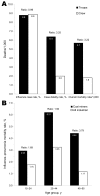Deaths from bacterial pneumonia during 1918-19 influenza pandemic
- PMID: 18680641
- PMCID: PMC2600384
- DOI: 10.3201/eid1408.071313
Deaths from bacterial pneumonia during 1918-19 influenza pandemic
Abstract
Deaths during the 1918-19 influenza pandemic have been attributed to a hypervirulent influenza strain. Hence, preparations for the next pandemic focus almost exclusively on vaccine prevention and antiviral treatment for infections with a novel influenza strain. However, we hypothesize that infections with the pandemic strain generally caused self-limited (rarely fatal) illnesses that enabled colonizing strains of bacteria to produce highly lethal pneumonias. This sequential-infection hypothesis is consistent with characteristics of the 1918-19 pandemic, contemporaneous expert opinion, and current knowledge regarding the pathophysiologic effects of influenza viruses and their interactions with respiratory bacteria. This hypothesis suggests opportunities for prevention and treatment during the next pandemic (e.g., with bacterial vaccines and antimicrobial drugs), particularly if a pandemic strain-specific vaccine is unavailable or inaccessible to isolated, crowded, or medically underserved populations.
Figures





Comment in
-
Time from illness onset to death, 1918 influenza and pneumococcal pneumonia.Emerg Infect Dis. 2009 Feb;15(2):346-7. doi: 10.3201/eid1502.081208. Emerg Infect Dis. 2009. PMID: 19193293 Free PMC article. No abstract available.
References
-
- Opie EL, Blake FG, Small JC, Rivers TM. Epidemic respiratory disease. St. Louis: C.V. Mosby Co.; 1921.
Publication types
MeSH terms
LinkOut - more resources
Full Text Sources
Other Literature Sources
Medical
